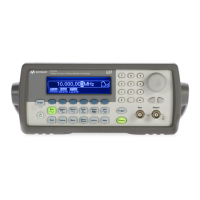248
Chapter 4 Remote Interface Reference
Phase-Lock Commands (Option 001 Only)
4
• The specified phase adjustment causes a “bump” or “hop” in the
output waveform in order to change the phase relationship to the
external signal to which it is currently locked.
• This phase adjustment for phase-lock applications is independent of
the burst phase as set by the BURS:PHAS command (see page 215).
UNIT:ANGLe {DEGree|RADian}
UNIT:ANGLe?
Select degrees or radians to set the phase offset value using the
PHAS command (remote interface only). The default is DEG. The :ANGL?
query returns “DEG” or “RAD”.
• From the front panel, the phase offset is always displayed in degrees
(radians are not available). If you set the phase offset in radians from
the remote interface and then return to front-panel operation, you will
see that the function generator converts the phase offset to degrees.
PHASe:REFerence
Immediately sets a new zero-phase reference point without changing the
output of the function generator. That is, this command resets the phase
value returned by the PHAS? command but does not affect the output
waveform. It is equivalent to the Set 0 Phase softkey in the front panel
“Utility” menu. See “External Timebase Reference (Option 001)” on
page 137 for further information. This command does not have a query
form.
PHASe:UNLock:ERRor:STATe {OFF|ON}
PHASe:UNLock:ERRor:STATe?
Disable or enable the function generator from generating an error if
the phase-lock is ever lost. The default is OFF. If the phase-lock is lost
and the error is enabled, a “Reference phase-locked loop is unlocked”
error is generated. The unlock error setting is not stored in non-volatile
memory. That is, the setting will be lost when the power is cycled. The
:STAT? query returns “0” (OFF) or “1” (ON).
33210A users guide.book Page 248 Wednesday, July 16, 2008 11:16 AM

